From a cavernous former balloon hangar to a circus tent to an intimate dance venue, Neville Pearsall has probably worked in more performance spaces than any other resident Jefferson County “sound …
This item is available in full to subscribers.
We have recently launched a new and improved website. To continue reading, you will need to either log into your subscriber account, or purchase a new subscription.
If you had an active account on our previous website, then you have an account here. Simply reset your password to regain access to your account.
If you did not have an account on our previous website, but are a current print subscriber, click here to set up your website account.
Otherwise, click here to view your options for subscribing.
* Having trouble? Call our circulation department at 360-385-2900, or email our support.
Please log in to continue |
|
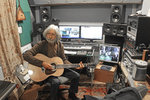
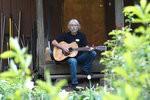
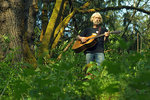
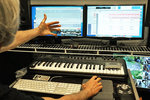
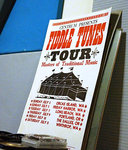
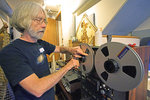
From a cavernous former balloon hangar to a circus tent to an intimate dance venue, Neville Pearsall has probably worked in more performance spaces than any other resident Jefferson County “sound guy.”
Pearsall, 63, recently moved his recording studio, Synergy Sound, from Building 315 at Fort Worden State Park to his house in a remote, wooded area of Chimacum.
“Almost everybody in town’s come through” his Fort Worden studio in his 21 years there. His home studio is about one-third of its size, but it’s all he generally needs, he said; he records “a lot of duos and trios.”
Pearsall still does sound for “major events” for Centrum at Fort Worden, including the Choro, Voice Works, Fiddle Tunes, jazz and ukulele festivals, and he also handles the Port Townsend and Chimacum high school graduations; “almost everything at [McCurdy] Pavilion.”
The pavilion, a renovated and expanded former U.S. Army observation balloon hangar from 1921, is a challenging space in which to do live sound. “They need about $10,000 worth of sound absorber,” he said. “I do the best I can.”
In his home studio is a decades-old Fiddle Tunes poster with a drawing of the “Mule Barn Tent,” which once hosted concerts for Centrum’s popular annual festival. The tent was set up at the old mule barn in the years before the cavernous hangar was remodeled in 1991 as McCurdy Pavilion, which proved to be a more readily accessible venue for shows.
In some ways, sound engineering in the tent was easier than the pavilion, Pearsall said. It had “an interesting billowing sound” when the wind blew.
He also does sound at the Wooden Boat Festival, “probably the hardest job of the year,” and for “15 or 20 years,” he’s done sound for the big square/contra dance stage at Seattle’s annual Northwest Folklife Festival, which is “four days, 12 hours a day.”
EIGHT-TRACK
After earning a degree in ethnomusicology from the University of Washington, Pearsall worked assembling audio mixers at TapCo, an Edmonds company that “made one [mixer] that musicians could afford.” He operated a recording studio out of his home in Seattle until 1980, when he moved to Jefferson County and built his home in Chimacum.
Before switching to the ethnomusicology department, he had been in the architecture school at the UW. “I found out they were having all this fun over in the music department.” He mentioned Dumi, a visiting professor who helped popularize the marimba, whom Pearsall recorded with his eight-track machine.
“A lot of [ethnomusicology] was collecting things out in the world,” meaning capturing the music played by people in Africa, Vietnam, the Balkans and elsewhere. “I recorded a lot of people on half-inch tape.”
He recorded Scott Cossu’s first album on the eight-track, “one of the first new age or Windham Hill–type recordings,” and made recordings of artists from around the world for his ethnomusicology studies. He still has the bulky equipment that, back then, was the ultimate in portable technology.
Pearsall also archives people’s recordings for them, transferring eight-track or other types of tape to digital formats.
The tape that was thought to have the best quality in 1975-1985 turned out to absorb moisture; he uses a food dryer to bake the tape for 12-24 hours. “Much of the tape that I archive for people from that era has to be baked,” he said. “Big problem for the Library of Congress.”
“Digital files are always changing, too,” he observed. “They’re always changing the format. That’ll be a big problem for the future…. CDs are disintegrating, too. It’ll be interesting to see if they still play in 50 years.”
DIGITAL VS. ANALOG
Surrounded by his computer screens, as well as some relics, such as his big Ampex tape recorder, Pearsall said he is “firmly in the digital camp.”
His career spans the shift from analog to digital recording technology, and he’s still got a lot of old equipment alongside the latest digital tools.
He points to his computer screen, where wide rows of moving lines show 20 tracks layered together into the song playing on the speakers. “This’d be racks and racks and racks of stuff – and now it’s all on the computer.”
Digital recording allows endless tinkering, manipulating the way the sound of the different instruments or sounds are input for a given song. “With this kind of thing, you can tweak it forever.” The technology allows a bewildering amount of variations to be applied. “Some people can never decide it’s done,” he said. “That’s one of the beauties of recording live on tape.”
He likes the sound of tape recordings, “but I like being able to call up my project and it’s pretty much exactly the way I left it.” Digital recording is cheaper. “People I work with want to spend on the whole project about what the tape would cost.”
He charges about $40 an hour for musicians looking to record. “Some can record a whole CD in two or three hours,” he said. “Others can’t record a whole song in two or three weeks.”
Those who are well rehearsed record more efficiently. He recalled a group of street performers whose first or second take was just right. “Getting people comfortable is half the battle,” he said. “Sometimes, I can trick people,” directing them to rehearse one more time and recording that version without telling them he’s recording.
PLAYING LIVE
The inability to tweak is one of the great things about doing live sound, he said. “It is what it is. It’s just out there.”
He plans to buy a live sound digital mixer, but “each year the price halves and they add more features,” so he’s waiting for the right moment.
One of the drawbacks of doing live sound, though, is giving up your weekends. For 25 years, he said, he “never had a weekend off in the summer.” Now, he’s “hoping to play more and work less.”
He recently produced a CD of songs he wrote and arranged, combining his guitar and vocals with accompaniment by various people he’s recorded, including Orville Johnson and Danny Barnes.
Sound engineers have a unique role in a performing-arts mecca like Port Townsend.
“What other job can you take $20,000-$30,000 worth of stuff and 20-30 years of experience, do 12 hours of work and have people try to beat you down for $150?” Pearsall asked.
On top of that, “Everything’s a benefit [event]” for something, so you feel a little guilty asking for more money. “And you say, ‘I just want $200, so I can make $5 an hour,’” he said.
“That’s the problem with live sound. So, given a choice, I’d just do recording. Given another choice, I’d just play my guitar all day.”